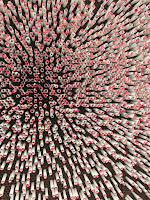 |
| Jordan inside the "Daydream v2" exhibit. |
On Sunday, my daughter and I attended the Wonderspaces exhibit in San Diego. It is described on their website as "a pop-up museum of extraordinary experiences." Each of these experiences was given their own space in which to reside so that each piece could speak its own voice, without the presence of the others.
 |
| "The Last Word" exhibit |
Sir Ken Robinson stated that "If you want to shift culture, it's two things: its habit and its habitats - the habits of mind, and the physical environment in which people operate" (2010). Each of these exhibits was setting out to shift the culture, through both mind and environment. Which makes me ask the question, why aren't schools creating wonderspaces? Ron Ritchhart, in Creating Cultures of Thinking, explains:
So what do we value in our classrooms? Judging by the rows of desks I still see in many schools across the nation, we value individual, quiet, one-directional transfer of knowledge. If learning is a creative and imaginative process, like we say it is, then isn't it our moral imperative to bulldoze the industrial era culture and bring in wonderspaces? What would that look like for you? Your students? Dream big and share your ideas below.

Comments
Post a Comment